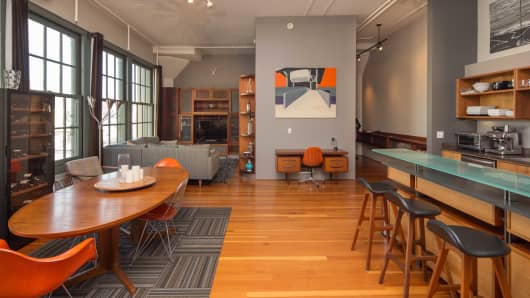Steven Bock thought he was a typical downsizing baby boomer. With his second child graduating from college, he and his wife felt it was time to put their 7,000 square foot, multimillion dollar, suburban Boston home on the market and head into the city to rent. What they found changed the plan entirely.
“We were looking in town, and the properties we were looking at, in the size range we wanted to rent, were extremely expensive. A couple thousand square feet is not really tax efficient, and what were we going to do with all our stuff?” said Bock.
So they turned their sights back to the Boston ‘burbs, this time in search of a single-family home for rent.
“We found a brand new house in Lexington owned by an investor, and it was perfect. Not small. It’s a lot less of a hassle. We have a ton of flexibility. We can let the lease run out and move. We can renew year to year if we want, so it was the best of all worlds,” said Bock.
The rent is high but slightly less than what the Bocks were paying on their previous home, when you add property taxes and maintenance to the mortgage payment. They were also able to take the equity from the sale of their home and use it for other investments.
“It was more a capital allocation, flexibility, lifestyle change,” Bock concluded.
Sky-high rents for luxury rental buildings in urban centers are shifting the rent-vs.-buy equation on the high end. For much of the nation, it’s less expensive to buy than to rent. Homeownership in cities such as Atlanta, Boston, Chicago, Cincinnati, Cleveland, Detroit, Milwaukee, Minneapolis, New York, Philadelphia, San Diego and St. Louis, on average, produces more wealth than renting a comparable property and reinvesting in stocks and bonds, according to a report by faculty at Florida Atlantic University and Florida International University. Dallas, Denver and Houston housing markets still favor renters.
“The increasing cost of renting relative to the cost of ownership, the unsteady performance of the stock market and the continuation of incredibly low mortgage financing are creating an environment in which the majority of U.S. housing markets are in buy territory,” said Ken Johnson, a real estate economist who is one of the survey’s authors.
On the high end, however, with larger loans, the rent/buy equation changes. Just looking at rents and prices in Boston, New York and Los Angeles, on the average four bedroom suburban home with a million-dollar mortgage, the average borrower is paying about $4,700 a month plus property taxes, insurance and maintenance. It adds up to nearly three times the average rent for the same property, according to Rental Beast, a real estate rental listing site. That doesn’t include the down payment on the home. The ownership premium only rises from there with the home price.
“We’re seeing growing demand for rentals in general, and high tides lift all boats. There are definitely more rentals in the suburbs,” said Ishay Grinberg, founder of Rental Beast. “People get priced out of the congested downtown areas, and they’re getting pushed out into the suburbs, so by default they’re renting single family homes.”
While homebuilders definitely scaled back on putting up “speculative homes,” or homes without buyers, after the housing crash, some still took a gamble; that gamble isn’t paying off as well as some had hoped. Home sales on the high end are softening, likely due to stock market volatility and general consumer queasiness. In order to recoup costs, Grinberg said, builders are being forced to rent some of these homes.
And that was a bonus for the Bocks. They were able to move into a brand new, 5,000-square-foot home and have no responsibility for the maintenance or taxes. They also have plenty of room to put their stuff.
[Source:- CNBC]







